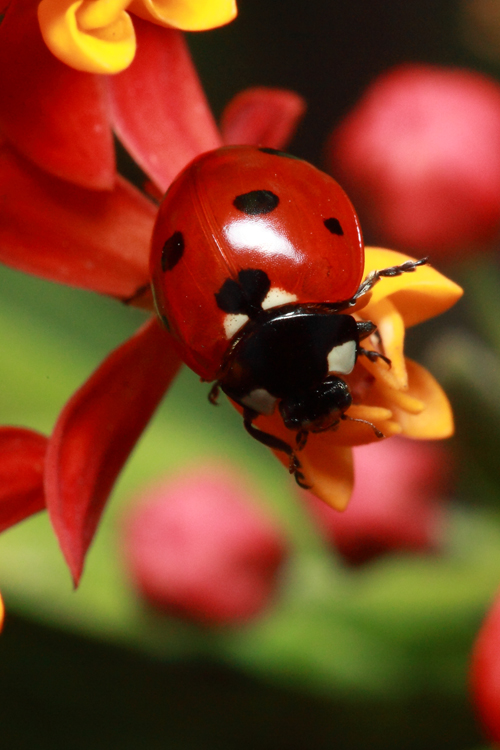
The lady beetles that come naturally to your garden are likely to have more impact on pests than ones you buy and release. Photo by M. Merchant.
Today I received a call from a Master Gardener who wanted to advise a local organic garden on the best beneficial insects to release to control pests. My answer surprised her a little. I generally recommend against gardeners releasing beneficial insects.
It’s not that I am opposed to biological control, or don’t believe in the value of predatory and parasitic insects. I know that releasing insects to control other insects is a time-honored, and historically successful, approach to pest control. The annals are full of stories of highly successful programs to introduce exotic beneficial insects into locations where new pests have become established(read about the vedalia (lady) beetle that saved the U.S. citrus and the miraculous control of Klamathweed by a tiny beetle) .
Nevertheless, stories like these have had the unfortunate result of convincing many people that controlling pests is as simple as opening a box to release a beneficial insect. It’s not so simple. Consider some of the insects commonly recommended for backyard sowing…
The lady beetle is photogenic, but it flies away too quickly to do much good. Trichogramma wasps, tiny egg parasites of caterpillars, have had the fight bred out of them in rearing laboratories, and have not proved effective when released in trees to control caterpillars. And the intimidating praying mantid can’t reproduce quickly enough, and is too general in its food preferences, to control garden pests.
Before being branded a party pooper, I do think there are practical things that gardeners (organic and low-impact gardeners especially) can do to encourage good bugs. The answer is not buying and releasing expensive beneficial insects (although they do have their place), but rather making your garden more attractive to good insects.
There is much to still learn about this approach to gardening, but the principles are relatively straightforward. If you plant a physically heterogenous garden (e.g., tall plants/short plants, evergreen/deciduous, grassy/broadleafed), with lots of year-round nectar and food sources, the good bugs will come. If this idea intrigues you, some excellent resources are available with a few clicks of the keyboard.
Mother Earth News has a nice list, gleaned from work of entomologists, of plants well-suited to attracting beneficials to your garden. As ME reminds us, besides attracting predators and parasites, these plants are attractive to many pollinators which can further enhance the yield of your vegetable garden.
Several great resources are also available through the work of Michigan State University’s Cooperative Extension. To learn more about their website and Extension publication on this subject, go to the eXtension website.
The challenge is how to design a garden that provides space for vegetables and plants that attract good bugs. And, if you don’t live in the community where studies have already been conducted, discovering what companion plants are best for your backyard may be in your future.
Let’s not give up on enlisting beneficial insects in our pest battles. But let’s focus on where we can do the most good, namely helping the millions of good guys find your garden and thrive there.